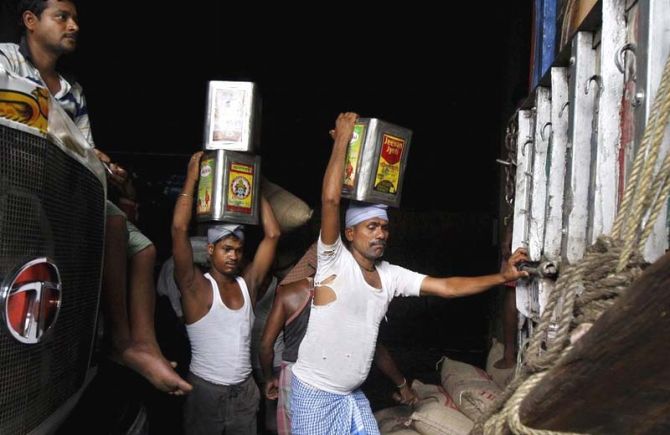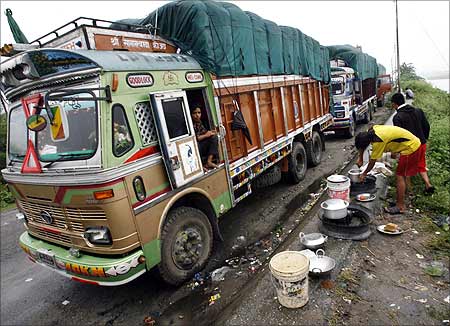The panel's recommendations question the architecture of the goods and services tax, going far beyond the arithmetic calculation, but its proposal of an interim two-rate structure is far from optimal, says Satya Poddar.
 The panel headed by Chief Economic Adviser (CEA) Arvind Subramanian prescribes 'sanjeevani' of broad base and low rate for the wounded goods and services tax (GST) lying unconscious in the battlefield of Parliament.
The panel headed by Chief Economic Adviser (CEA) Arvind Subramanian prescribes 'sanjeevani' of broad base and low rate for the wounded goods and services tax (GST) lying unconscious in the battlefield of Parliament.
The panel's recommendations are bold and far-reaching. They go far beyond the mere arithmetic calculation of the revenue neutral rate (RNR), to question the flaws in the GST architecture enshrined in the 122th Constitutional Amendment Bill.
Getting the GST design right is critical if it is to be a game-changing tax reform that facilitates "Make in India by Making One India", promotes ease of doing business, simplifies tax administration, encourages voluntary compliance, and protects revenue without fuelling inflationary pressures in the economy.
Tax rates cannot be decided in isolation of the GST design. The panel describes these inter-linkages using the example of taxation of gold (and other precious metals) under GST.
At the same time, it cautions that governments cannot cherry pick low tax rates if the exemptions are not curtailed or eliminated.
Above all, the panel's deliberations chart a new course in tax policymaking in India, based on facts and analytical rigour, in sharp contrast to the ad-hoc process followed by governments in the past.
The panel has gathered data on tax burdens on different commodities, which highlight cases where outcomes are perverse to policy objectives.
This should allow more informed policy debates and discussions in the future.
While public interest has been limited to GST rates, the panel calls for a thorough overhaul of the GST design and the enabling constitutional framework for it.
Here are their key recommendations: The excessive selectivity and discretion under the current regime of "Exemptions Raj" should be curtailed.
Even exemptions for health and education are not consistent with social policy objective and can be eliminated.
The enabling Constitutional framework should not exclude petroleum, electricity, alcohol and real estate from the GST base. These exclusions will create economic distortions, and result in blockage of credit for taxes paid on production / distribution inputs.
The additional cost burden adversely affects investments and growth.
Keeping any sector or commodity out of the GST base also create a bias in favour of imports as against domestic manufacturing.
The one per cent tax on inter-state supplies should be scrapped as it will balkanise the common market of India, and favour imports, thus defeating the twin objectives of 'Make One India' and 'Make In India' States should not be given the flexibility of having "band" of rates, which can complicate tax administration.
The panel suggests India should strive towards a one-rate structure, which has been worked out to be between 15 and 15.5 per cent (Centre and states combined). Anticipating political difficulties in extending the tax at this rate to hitherto exempt items, the panel recommends an interim two-rate structure:
A low rate of 12 per cent and standard rate of 18 to 19 per cent (if the precious metals tax rate is kept at two per cent).
While these rates are lower than the 27 per cent rate originally proposed by the Empowered Committee of Finance Ministers, the structure proposed by the panel is far from optimal.
The international best practice is to introduce GST at a single rate, generally not more than 10 per cent.
Japan, Singapore, Australia, New Zealand, and Malaysia, levy GST at a single rate which at inception was three per cent, three per cent, 10 per cent, 10 per cent, and six per cent, respectively.
The standard rate of 18-19 per cent proposed for India would be debilitating for telecommunications, banking and finance, and transportation sectors which are so vital for the economy. It leaves no room for future growth in the tax.
A moderate GST rate obviates the need for the two-rate structure.
Dual rates will add to classification disputes and open a new warfront which will see hectic lobbying by industries to push their products in the lower rate basket.
Given Indian market conditions, a high standard rate will perpetuate non-compliance.
While the RNR workings of the Panel are awaited, indications are that the 15 per cent RNR estimate is based on the assumption of the goods tax base remaining the same as under the state value-added tax (VAT), and of services as under the Service Tax; alcohol is to remain outside the scope of the GST; and only a modest improvement in compliance.
If, instead, the rate were to be calculated on the basis of a broader base, including alcohol, the RNR would come down to 13 per cent, even assuming no further improvement in compliance.
The rate can be brought down further to 12 per cent, if the demerit goods and luxuries are subjected to a special higher rate, as recommended by the panel.
At this rate (with special low and high rates for precious metals, and demerit/luxury goods), there would be no need for the interim two-rate structure recommended by the panel.
Governments would earn a significant fiscal dividend from better compliance, more consumer spending, and higher gross domestic product.
The panel rightly points out that the GST tax design is profoundly political and contingent.
The panel's report is a significant breakthrough in the entire GST debate. We expect that the detailed report will give more details and enable an informed discussion.
It would put GST back on track and allow for some open and informed discussions, which until now were limited to closed doors without involving the taxpayers.
The recommendations of the panel are merely a prescription and the final decision on GST rates and other design features will be taken by the GST Council.
If the Council chooses not to abide by the prescription, GST may turn out to be a dead duck.
Satya Poddar is senior advisor at EY










